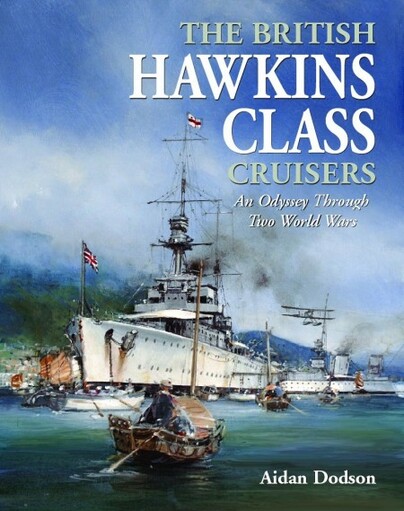
The British Hawkins Class Cruisers. An Odyssey Through Two World Wars. By Aidan Dodson. Seaforth Publishing, a Division of Pen & Sword Books Ltd, Barnsley, 2024. ISBN 978 1 3990 5612 0 (hardback) ISBN 978 1 3990 5613 7 (epub)
Reviewed by David Hobbs
This is a first-class study of an interesting class of cruisers that, in addition to the normal duties of cruisers, included ships that served as a prototype aircraft carrier, flagships on overseas stations, officer cadet training ships and as a fleet maintenance and repair ship.
Aidan Dodson has written more than thirty books, some of which, including Before the Battlecruiser, The Kaiser’sBattlefleet and The Windfall Battleships, also published by Seaforth, will be familiar to ANI members. He is also a regular contributor to the annual journal Warship and, when not following his long-standing interest in naval historical research, he has been Professor of Egyptology in the Department of Anthropology and Archaeology at the University of Bristol since 1996.
This is a well-illustrated, large format book that describes the design, construction and careers of the five ships that constituted this class. There are over two hundred black and white photographs that illustrate every phase of these ships varied lives, complemented by five colour, fold-out ‘as fitted’ drawings, ten maps and forty sets of black and white drawings. The latter were drawn by the author who also drew the ten coloured side views showing the different ships at various stages of their careers that appear just inside the covers.
Interestingly, two of the five ships were lost when they could not be recovered after grounding on rocks whilst navigating close to the shore in difficult conditions; HMS Raleigh off Labrador in July 1922 and HMS Effingham off Skjoldash Island in Norway during May 1940. The author follows a logical sequence with chapters describing the origins of the class design, the completion of HMS Vindictive as an aircraft carrier, the completion of the remaining ships of the class and the various conversions they underwent. Subsequent chapters describe individual ships’ careers in some detail and even the various plans for their modernisation that were never carried out. These were large cruisers and Dodson describes the influence their design had on subsequent classes, especially the County class heavy cruisers. The impact of the Washington and London Treaties had on these ships and the influence their existence had on the treaties are discussed and bring new perspectives to the historiography of warship design between 1918 and 1939.
None of the class served in Australia but they proved ideal ships for the Royal Navy’s extensive pre-1939 world-wide dispositions including both the China and America and West Indies Stations. The author’s descriptions open a window, therefore, into a period of naval operations with which many RAN officers who served with the RN would have been entirely familiar. Vindictive’s role in combat operations against the Bolsheviks in the Baltic during 1919 is well covered and it is testimony to his depth of research that he has managed to identify every individual aircraft that was embarked in her throughout her significant career, including time spent after modification as a seaplane-carrying cruiser on the China Station. Ships’ time spent in reserve and with minimal ships’ companies on trooping duties to the Mediterranean and Far East are described, further enhancing the description of operations within a navy with enormous global commitments and a number of ships held in maintained reserve status.
The original main armament of hand-loaded 7.5-inch guns was unique to this class and Dodson explains that the 200lb shells were at the limit of what could be achieved without power-loading. Sustaining fire in a prolonged action would have been almost impossible but several attempts to replace them with power-worked turrets came to nothing because budget restriction or treaty limitations prevented them from being taken forward. HMS Effingham, the one ship that was eventually modernised, was refitted with a main armament of hand-worked 6-inch guns with 100lb shells that could be hand-loaded practically. The use of some of the class as cadet training ships is described with drawings showing what changes were made to the ships to fit them for the task. By 1940 the surviving ships were outdated for fleet work but proved ideal as convoy escorts, guarding merchant shipping against enemy surface raiders in the Atlantic and Indian Oceans. Two served as bombardment ships off the Normandy beaches in 1944.
In addition to the wealth of material in the main test, there are appendices that give detailed ship specifications, summaries of individual ship careers, details of the guns and mountings carried by the class and details of the various aircraft types embarked and the catapults that were used to launch them. Commanding officers and cruiser squadron flag officers are listed and there is a most useful graphic showing every RN cruiser’s allocation between 1919 and 1939.
This book describes the Hawkins class and the cruiser operations of the fleet in which they served during a period of history that has been overshadowed by the Second World War and received less attention than it deserves. There is much that will resonate with historians who have studied the RAN’s cruiser operations during the same period and the book adds to the historiography of cruiser design and deployment. It is written in a very readable style and I thoroughly recommend to whose interests lie in this period.



